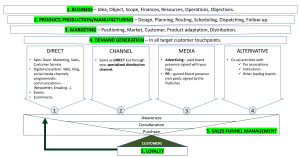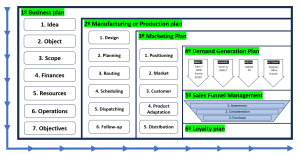by Diego San Román

In activities where orderly work is crucial, checklists are used—sequential checkpoints that no one skips, considering the potentially disastrous consequences of doing so. Airline pilots, surgeons in the operating room, and engineers working on projects that could fail without a set order always follow rigorous checklists.
Interestingly, in the business world, few companies use checklists to control and ensure that the processes and methodologies needed to achieve their objectives are recorded, reviewable, and replicable. These checklists help understand what was done well, what was not, and allow corrections while promoting internal alignment so that the entire team understands its contribution to the business operation.
Trust in “genius” and “intuition” is often overvalued, even though the world is full of “geniuses” with great ideas who have not achieved success due to the lack of a systematic methodology and reliance only on intuition.
Most of the “geniuses” who succeed in creating businesses or value propositions that work are those who recognize the value of method and apply it as the foundation for action, incorporating it into their genius to achieve better results. These individuals create companies and business projects that generate impact, survive, and add value to all stakeholders. A few benefit from luck, defined as “being in the right place at the right time with the right proposal,” to achieve success without applying structured processes and methodologies. This is akin to winning the lottery. However, even in such cases, to maintain success, it is advisable to incorporate a checklist like the one proposed in this book.
Below is a basic checklist that anyone starting, developing, and managing a business could follow to increase their chances of success:
- Business Idea. To be viable and successful, a business idea generally must meet several key characteristics:
- It must offer a clear and effective solution to an existing problem or need in the market.
- There must be a sufficiently large market willing to pay for the proposed solution.
- It must have a unique proposition that distinguishes it from competitors, whether through innovation, quality, cost, or service.
- It must have the potential to grow and expand in the market, with the ability to adapt and scale.
- It must be financially viable, with the capacity to generate income and sustained profits.
- It must be sustainable in the long term, both in operations and environmental and social impact.
- It must be implementable with available technology and resources.
- It should be easy to understand and communicate to potential investors, partners, and customers.
Additionally, the business idea must align with the entrepreneur’s capabilities, skills, interests, and resources. Key considerations include:
- Skills and experience: The idea should fit the entrepreneur’s skills and experience.
- Passion and motivation: The entrepreneur must be passionate and motivated by the business idea, as entrepreneurship requires significant dedication and hard work.
- Available resources: The idea must be viable within the financial, human, and technological resources the entrepreneur can access or mobilize.
- Lifestyle compatibility: The business idea should align with the entrepreneur’s desired lifestyle.
- Personal and professional goals: The idea should support the entrepreneur’s long-term personal and professional goals.
These factors ensure that the business idea is not only sound in theory but also practical, sustainable, and fulfilling for the entrepreneur.
- The Business Strategy
According to Richard Rumelt’s “Good Strategy Bad Strategy” approach, strategy should precede planning. Strategy sets the framework and direction the organization must follow to address its specific challenges and achieve its goals. Without a clearly defined strategy, any plan lacks focused purpose and effectiveness. The elements of a well-defined strategy include:
- Clear diagnosis: Identifies and diagnoses the challenge or opportunity facing the organization.
- Guidance policy: Establishes a clear direction or approach for addressing the identified problem.
- Coherent actions: Develops specific, coordinated actions aligned with the guidance policy to solve the diagnosed problem.
- The Business Plan
A business plan details the company’s ideas, objectives, and operational plans. It defines purpose, scope, objectives, resources, and business operations. The key elements include:
- Business concept: describes the original idea and its development at structural, organizational, and operational levels.
- Scope: defines the desired business size and its impact on strategy, organization, and operations.
- Economic model: examines the market, competition, economic impact, sustainability, and environmental impact.
- Financial model: analyzes resource needs, expected returns, risk, cash flow, and profitability.
- Operating model: details how the business will function to generate value for its customers and stakeholders.
The business plan should also have a Product and Manufacturing/Production Plan, a Marketing Plan, a Demand Generation Plan, a Sales Management Funnel Plan and a Loyalty Plan.
- Product and Manufacturing/Production Plan
This plan describes the operations necessary for product manufacturing or service provision, covering:
- Product conceptualization and design.
- Planning and execution: detailing all the elements and steps necessary to turn a design or concept into a physical product or service, and deliver it to the customer.
- Roadmap of materials and processes: define the path that materials, components, and subassemblies will follow throughout the manufacturing process until they become the finished product.
- Scheduling: involves taking into account batch sizes (in batch production), setup times, and the required delivery or completion dates to determine when orders should be released for production.
- Dispatching: refers to releasing orders, materials, and tooling for production.
- Tracking: the review of process stages, their implementation, and the outcome to identify opportunities for improvement.
- Marketing Plan
The marketing plan defines the key variables for achieving sales of the company’s value proposition. These include:
- Desired positioning: defines how the company wants to be perceived by target customers and stakeholders.
- Market: specifies the markets where the value proposition will be sold.
- Target customer: identifies who the product or service is most relevant for.
- Product adaptation: tailors the product to be relevant to the largest number of target customers.
- Distribution: determines the best way to deliver the value proposition to customers.
- Demand Generation Plan: actions across all points of contact that generate the sales funnel. The goal is to move as many interested parties as possible through all the phases of the funnel to the final stage. To create a complete demand generation plan, we must consider all the possible actions we can implement at each one of the four potential points of contact with prospects and customers, including:
- Direct point of contact: Everything you can do to directly reach your prospects and customers with your sales pitch, without intermediaries. In this section, you can define and execute actions to equip your sales team (Marketing, Sales, and Customer Service) with the necessary informational and training materials to communicate with prospects and customers effectively. You can also design and maintain a digital ecosystem with your own digital media—website, blog, social channels, and digital communications (newsletters, email marketing, etc.)—optimized to reach the largest number of prospects and customers. Additionally, you can organize or attend events relevant to your industry and your customers. Finally, you can define, implement, and maintain an online store where you can pre-sell or sell your products and services.
- Point of contact through the associated specialized distribution channel: Everything you can do to reach your distribution partners’ customers, who are potential customers for you, and to involve the channel in the dissemination and sale of your value proposition. This is what we traditionally know as “Channel Marketing.”
-
- Channel Marketing: Focuses on strategies and tactics to optimize the distribution of products through different sales channels, such as retailers, distributors, or online platforms. The goal is to maximize the product’s reach and effectiveness in the market through these channels.
- Trade Marketing: Focuses on strategies aimed at intermediaries (such as wholesalers and retailers) to encourage the promotion and sale of the product. It involves activities such as promotions, merchandising, and relationship management with distributors to ensure the product is well-positioned and accessible at points of sale.
Since your distribution partners are businesses, many will have their own sales teams, digital ecosystems, attend and organize events, and run their online stores. Therefore, you can co-define and co-implement actions with each of these distribution partners to position yourself favorably with their prospects and customers.
- Point of contact through the media: Actions you design and carry out through the media. This is what many business professionals refer to as “doing marketing.” However, as we’ve seen, “doing marketing” involves creating the marketing plan, the demand generation plan, managing the sales funnel, and defining and implementing the loyalty plan. In this section, you can do two things:
-
- Advertising: Purchase media space that aligns with your defined target audience and convey your advertising message through that space. This could include advertising in any format, sponsorships, events, branded content, etc. Advertising has two facets: one outside the point of sale, which aims to bring as many potential customers as possible to the point of sale, and one inside the point of sale, which seeks to get the highest number of those potential customers to buy your value proposition.
-
- Public Relations: Generate content attractive enough to interest media outlets aligned with your target audience, prompting them to publish it. This could include press releases, interviews, industry studies, events, etc.
- Point of contact through alternative channels: This involves defining demand generation actions in collaboration with professional associations and institutions whose members are potential customers for you. These associations include industry organizations, chambers of commerce, etc. It also includes joint actions with other brands whose customers are likely to be potential buyers of your value proposition. These other brands may include influencers and opinion leaders in your sector.
- Sales Funnel Management
The sales funnel has three phases:
-
- Awareness: reaching the target audience to introduce your value proposition.
- Consideration: prospects evaluate the value proposition to satisfy their (functional and emotional) need.
- Purchase: prospects buy the value proposition, becoming customers and hoping it satisfies their needs.
- Loyalty Plan. The goal of the loyalty plan is to build and maintain emotional connections with customers, ensuring they continue to choose the company’s brand over competitors. Successful loyalty plans increase trust, brand affinity, and customer retention.
By following this structured checklist, businesses can avoid common pitfalls and set themselves up for long-term success.
Seen in graphic format, the process would look like what I show below. It is very useful to view it in this format to have a “bird’s eye view” of the entire process, allowing us to identify common elements and possible synergies to maximize the efficiency of the plan and, consequently, make it more effective:

Figure 1: Complete Business Plan Model – Factus Consult.
Order is very important. For example, before understanding and clearly establishing the product, market, target audience, and desired positioning, an advertising campaign should not be considered. This is a mistake many companies make. Doing so constitutes a poor investment, leading to the loss of valuable resources and brand equity by delivering the wrong message to the wrong audience, through the wrong set of media, and at the wrong time.
As a complete plan structure, the order to follow and the detailed hierarchy of the elements, from top to bottom and from left to right, would be represented as follows:

Figure 2: Business Plan Hierarchy and Order (in the direction of the blue arrow).
Before turning the original idea into a business plan, to fully understand the business opportunity or value provision in a market, it is crucial to know where that opportunity lies. We must assess whether potentially competitive solutions already exist, how they are positioned, and the trends to estimate how that market will evolve with its corresponding needs and existing solutions. Therefore, throughout this process, sufficient research is needed to define the right product, the real market, the customer profile, and the best distribution channels, aligning our value proposition and communication competitively.
This research should be a continuous exercise, and it is wise to invest time and resources to understand the correct relative position of the business concerning the competition and to properly define the ever-changing target customer profile. This enables accurate segmentation and audience selection, without which no commercial communication actions should be considered.
The order to follow when planning and executing the business with replicable and sustained success is obtained by formulating and answering in detail the following questions:
– What is the focus, model, and purpose of the business, and how will it sustain and grow?
– What value proposition (idea, product, service, etc.) is intended to be offered, and how does it position itself against alternatives—not only differently but uniquely? That is, the proposition that best fits the emotional and rational needs of the target customer. This unique value proposition must generate and maintain demand, creating profits for long enough to claim the previously defined positioning. Example: Volvo represents “safety” in the automotive market.
– What is the real market? Let’s remember the example of IKEA mentioned earlier.
– Who is the target customer? Who finds this proposal relevant, how much of the market do they represent, and how much influence and recommendation capacity do they have over others?
– What distribution is needed? Where can the customer access the value proposition, and through what physical and/or digital channels will they have the best purchase and consumption satisfaction? Example: Banking services for seniors (in-person at a branch or virtual with phone guidance) and for younger people (fully online).
– What positioning is needed, meaning how we want our stakeholders, especially our customers, in the selected market, to describe us. This is a key point because EVERYTHING we do in our company must communicate this desired description. Everything must be consistent with it. Any inconsistency with the definition we want from our customers and other stakeholders generates mistrust and diminishes the value of our brand and company.
– How do we gain attention, consideration, purchase, and recommendation? Once we know who the target audience is and understand how they behave as individuals (emotionally, in terms of values, and with their tension points to satisfy), as consumers (of all existing product and service categories), and finally as buyers (of the product category in which your value proposition belongs), we will have sufficient information to effectively communicate our value proposition to them. By doing so, we will also indirectly reach other audiences whose purchase decisions are influenced by this primary audience.
– How do we maintain attention and preference over time to ensure customers continue purchasing the company’s offerings and recommending its brand and value propositions to their circle of influence? Example: Loyalty plans and clubs, and proactive customer service/support follow-up.
By following these steps in order—that is, by creating and following a checklist—you will avoid the mistakes that some large brands and even entire sectors fail to address. These mistakes force them to backtrack, review, rethink, and patch up their strategies and/or activities, resulting in wear and tear, wasted time, and increased costs.
No matter how you look at it, houses are still built starting with the foundations. We could build it any way we like, even starting with the roof and building it upside down, as long as it does not need to last long. If you don’t understand, ask yourself how long you could live in this house:

Figure 3: A house difficult to live in.
In future articles, I will break down the details of how to create a checklist for each section of the business.
Author: Diego San Román Mendiguren, Partner at Factus Consult.
This article summarizes the methodology and focus of Factus Consult. In the Business Plan, Production or Manufacturing Plan, Commercial Plan, Demand Generation Plan, and Loyalty Plan models, it encompasses all areas.



